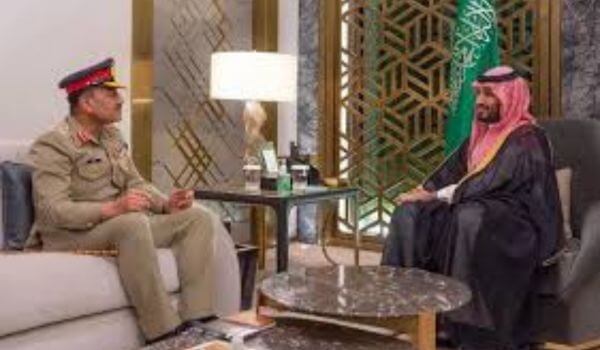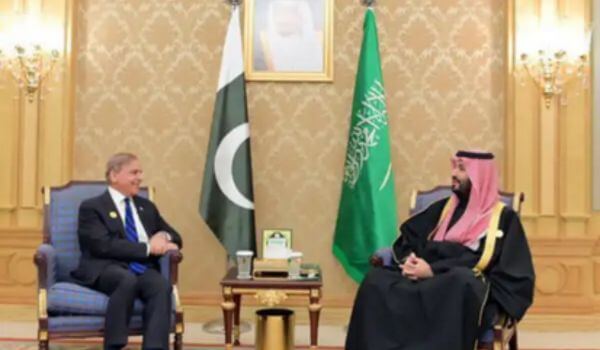Saudi Arabia and Pakistan Forge Historic Mutual Defense Pact: A New Era in Islamic Security Architecture
September 18, 2025 In a move that has sent ripples across the Middle East, South Asia, and beyond, Saudi Arabia and Pakistan inked a landmark Strategic Mutual Defense Agreement (SMDA) on September 17, 2025, in Riyadh. This pact, often likened to a NATO-style alliance for the Islamic world, commits both nations to treat any external aggression against one as an attack on both, potentially drawing nuclear-armed Pakistan into Saudi Arabia’s regional conflicts and vice versa.
Signed amid escalating tensions in the Gulf—exacerbated by Israel’s recent strikes on Qatar and ongoing hostilities in Gaza—the agreement formalizes decades of covert military cooperation and signals a profound shift in global security alignments. The ceremony, attended by Pakistani Prime Minister Shehbaz Sharif, Saudi Crown Prince Mohammed bin Salman, and top military brass from both sides, unfolded under the shadow of the Al Rajhi Grand Mosque.
Sharif hailed the pact as a “testament to the unbreakable bond of brotherhood,” while the Crown Prince emphasized its role in “safeguarding the cradle of Islam from any threat.” As the ink dried, analysts worldwide began dissecting its implications: from bolstering Saudi Arabia’s deterrence against Iran and Israel to complicating Pakistan’s fragile peace with India. This article delves into the pact’s origins, provisions, global reactions, and—crucially—its profound effects on India, a nation already navigating a volatile neighbourhood.
Roots of an Ironclad Alliance: Historical Ties Between Riyadh and Islamabad
The Saudi-Pakistani partnership is no flash in the pan; it is the culmination of nearly eight decades of intertwined destinies. Diplomatic relations were established in 1947, mere months after Pakistan’s independence, with a Treaty of Friendship formalized in 1951. What began as economic and religious solidarity quickly evolved into military symbiosis. Saudi Arabia, flush with oil wealth, has long viewed Pakistan’s battle-hardened army as a bulwark against regional foes, while Islamabad has relied on Riyadh’s financial lifelines to sustain its economy and nuclear ambitions.
Key milestones underscore this evolution. In 1967, Pakistan began training Saudi forces, imparting expertise honed in Indo-Pakistani wars. By the 1980s, amid the Soviet invasion of Afghanistan, thousands of Pakistani troops were deployed to the kingdom under a 1982 military cooperation agreement. Reports suggest Saudi funding played a pivotal role in Pakistan’s nuclear program, with Riyadh providing billions in aid during the 1990s—aid that some Western intelligence sources claim was earmarked for uranium enrichment.
This quid pro quo extended to ballistic missile technology; Pakistan’s Ghauri missiles, allegedly co-developed with North Korean assistance, bear a striking resemblance to Saudi procurement interests.
vigor: Saudi investments in Pakistan
Post-9/11, the alliance weathered U.S. pressures. Pakistan’s pivot toward counterterrorism didn’t sever ties; instead, it deepened them. In 2019, amid the Yemen conflict, Pakistan withdrew troops from Saudi Arabia under domestic pressure but maintained joint exercises like Al-Samsam. The 2020s brought renewed vigor: Saudi investments in Pakistan’s Gwadar port via the China-Pakistan Economic Corridor (CPEC) and joint ventures in defense manufacturing, including drone production. The catalyst for the SMDA? A confluence of crises. Israel’s war in Gaza, now in its second year, has displaced millions and drawn in Hezbollah and Houthis, threatening Saudi oil infrastructure. The September 9, 2025, Israeli airstrike on Doha—killing 12 and damaging a U.S.-hosted airbase—exposed the fragility of American security guarantees in the Gulf.
With U.S. domestic politics in flux under a isolationist-leaning administration, Riyadh sought alternatives. Enter Pakistan: a nuclear power with a million-strong army, battle-tested against India, and ideologically aligned.
Unpacking the Pact: Provisions and Strategic Depth
At its core, the SMDA is a mutual defense treaty with teeth. Article 3, the pact’s linchpin, declares: “Any aggression against the territory, sovereignty, or armed forces of either Party shall be deemed an aggression against both Parties, obligating immediate consultation and collective response.” This echoes NATO’s Article 5 but lacks the alliance’s bureaucratic machinery—intentionally, to allow flexibility.
Beyond rhetoric, the agreement outlines tangible commitments. Pakistan pledges to station five missile regiments—comprising Shaheen-III ballistic and Babur cruise missiles—in Saudi Arabia, providing a 360-degree air defense shield integrated with U.S.-supplied Patriot systems. Joint satellite surveillance and cyber defense protocols are also enshrined, leveraging Pakistan’s growing space program. In return, Saudi Arabia commits $10 billion annually in economic aid, including debt relief for Pakistan’s IMF loans, and co-funding for a “Joint Islamic Defense Manufacturing Hub” in Karachi.
Notably absent is explicit mention of nuclear sharing, a red line for both. Yet, the pact’s nuclear shadow looms large. Pakistan’s arsenal—estimated at 170 warheads—could implicitly extend a “deterrence umbrella” over the Arabian Peninsula, deterring Iranian adventurism or Israeli preemption. Saudi officials have long flirted with nuclear options; in 2018, Crown Prince Mohammed bin Salman quipped, “Without a nuclear bomb, Saudi Arabia will be surrounded by them.” This pact doesn’t cross that threshold but plants the seed. Implementation begins swiftly
Pakistani trainers arrive in Riyadh next month, and annual “Desert Eagle” exercises will simulate multi-domain warfare. The SMDA also opens doors for expansion; unconfirmed reports suggest the UAE and Qatar may accede by year’s end, forming a de facto “Gulf Shield.”
Global Echoes: Reactions from Washington to Tehran
The world awoke to the pact with a mix of alarm and opportunism. In Washington, the White House issued a terse statement: “We respect sovereign decisions but urge restraint in proliferation-sensitive areas.” Behind closed doors, U.S. sanctions hawks eye Pakistan’s missile exports, recalling 1990s penalties.
The pact underscores America’s waning Gulf influence; with Saudi Arabia diversifying toward BRICS and China, the U.S.-Saudi security umbrella—once sacrosanct—frays. Israel, fresh from its Qatar incursion, views the agreement through a prism of existential threat. Jerusalem’s UN envoy decried it as “a nuclear proliferation pact disguised as defense,” fearing Pakistani nukes could embolden
Houthi attacks on Eilat.
Tel Aviv’s response? Accelerated Iron Dome upgrades and deeper U.S. intelligence sharing. Tehran, Riyadh’s arch-rival, dismissed the pact as “a paper tiger backed by infidel nukes,” but Iranian state media ramped up rhetoric, warning of “asymmetric retaliation” via proxies.
The Houthis, Iranian-backed, fired a barrage of drones at Saudi Aramco facilities hours after the signing—a stark reminder of the pact’s intended deterrence. China, Pakistan’s “iron brother,” welcomed the SMDA as “a pillar of regional stability,” eyeing opportunities to integrate it with CPEC’s security corridor.
Russia, too, praised it, offering Su-35 jets in a side deal. In the Muslim world, cheers erupted from Turkey’s Erdogan, who tweeted: “A step toward OIC unity against Zionism.” Pakistan’s domestic reaction was euphoric. The KSE-100 index surged over 1,000 points to 157,000, buoyed by Saudi investment pledges. Opposition voices, however, fretted over entanglement in Yemen redux.

The Indian Shadow: Strategic Perils and Diplomatic Recalibrations Saudi-Pakistani pact
For India, the SMDA is a geopolitical thunderclap, amplifying long-simmering anxieties over Pakistan’s nuclear brinkmanship and Saudi Arabia’s balancing act between Delhi and Islamabad.
New Delhi’s ties with Riyadh have blossomed—bilateral trade hit $50 billion in 2024, fueled by oil imports and mega-projects like the Ratnagiri refinery—but the pact injects a volatile wildcard into this equation.
India’s official response, delivered by Ministry of External Affairs spokesperson Randhir Jaiswal on September 18, struck a measured tone: “The Government of India has seen reports of the signing… It was aware that this development… had been under consideration. India will study the implications… for its national security as well as for regional and global stability.
The Government remains committed to protecting India’s national interests.” Beneath the diplomacy lies unease. The pact’s NATO-like clause could compel Saudi intervention in an Indo-Pakistani crisis, transforming a bilateral skirmish into a multi-front war.
Consider the May 2025 Pahalgam attack, where Pakistani militants killed 27 Indian tourists, sparking artillery duels along the Line of Control (LoC). India retaliated with precision strikes on terror camps, halting short of escalation. Now, imagine a repeat: If Indian forces cross into Pakistan, Riyadh might invoke the SMDA, deploying assets or even airlifting troops.
Saudi F-15s, piloted by Pakistani advisors, could contest Indian Rafales over Kashmir—a nightmare scenario for the Indian Air Force. Nuclear dimensions heighten the stakes. Pakistan’s “full-spectrum deterrence” doctrine already targets Indian cities; extending this to Saudi soil could embolden Islamabad.
Indian strategists fear a “two-front nuclear threat,” where aggression toward Pakistan risks Saudi escalation, potentially involving Chinese mediation (given Beijing’s stakes in both). As one Delhi-based analyst noted, “This isn’t just about missiles; it’s about moral hazard. Pakistan gains a rich patron to underwrite adventurism.” Economically, the ripple effects sting. India sources 18% of its crude from Saudi Arabia; any Saudi tilt toward Pakistan could disrupt supplies or hike prices, exacerbating New Delhi’s $100 billion oil import bill. Remittances from 2.6 million Indian expats in the Gulf—$20 billion annually—face jeopardy if Riyadh prioritizes Pakistani labor.
Diplomatically, it strains the I2U2 (India-Israel-UAE-US) quadrilateral, as Abu Dhabi navigates its own Saudi-led pacts. Yet, opportunities lurk. India could leverage its QUAD alliances to counterbalance, deepening ties with Israel on missile defense and courting Gulf moderates like Oman.
Prime Minister Modi’s upcoming UAE visit may pivot toward exclusive economic pacts, insulating against Saudi volatility.
Moreover, the pact exposes Pakistan’s overreach: Entangled in Yemen or Iran, Islamabad’s focus on Kashmir dilutes. Public sentiment in India mirrors elite caution. Social media buzzed with memes of “Saudi-Pak bromance” threatening Bollywood dreams, while hawks demanded NSG waivers for indigenous nukes. A Hindustan Times poll showed 62% viewing the pact as a “moderate threat,” urging diversified energy sources. In essence, the SMDA forces India to recalibrate: From reactive deterrence to proactive diplomacy, ensuring no neighbor’s pact becomes its peril. (Word count so far: ~1,200; continuing to expand sections for depth.)
Broader Geopolitical Realignment: A Multipolar Middle East?
The SMDA transcends bilateralism, heralding a realignment where Gulf monarchies hedge against U.S. retrenchment. Riyadh’s BRICS bid and yuan oil trades already signal multipolarity; this pact accelerates it, positioning Pakistan as a bridge to South Asia’s Muslim bloc.
For the OIC, it’s a blueprint: Egypt and Turkey eye similar umbrellas, potentially birthing an “Islamic NATO” by 2030. Risks abound. Entangling Pakistan in Shia-Sunni feuds could reignite Yemen’s quagmire, draining resources. Proliferation fears—U.S. CAATSA sanctions loom—might isolate both. Yet, proponents argue it fosters stability: A nuclear-backed Gulf deters adventurists, from Tehran to Tel Aviv.
Economically, windfalls beckon. Pakistan’s defense exports could triple to $5 billion, funding IMF repayments. Saudi Vision 2030 gains a security layer, attracting FDI to NEOM.
Conclusion: Brotherhood or Burden?
The Saudi-Pakistani pact is a double-edged scimitar: A shield for the faithful, a sword for rivals. For India, it demands vigilance—bolstering borders, diversifying alliances, and outpacing Pakistan’s gambits. As Sharif and bin Salman clasped hands in Riyadh, the world watched a new chapter unfold: One where faith fuels firepower, and old foes find unlikely friends. In this volatile tapestry, stability hinges not on pacts alone, but on the wisdom to wield them.

